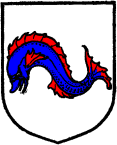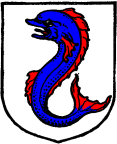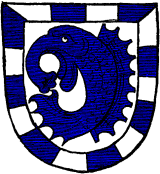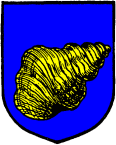

 |
 |
| FIG. 479.--Dolphin naiant. | FIG. 480.--Dolphin hauriant. |
 |
| FIG. 481.--Arms of the Grauffvon Dälffin lett och in Dälffinat (Count von Dälffin), which also lies in Dauphiné (from Grünenberg's "Book of Arms"): Argent, a dolphin azure within a bordure compony of the first and second. |
*1 Armorial bearings of Peebles (official blazon): Gules, three salmon naiant in pale, the centre towards the dexter, the others towards the sinister. Motto: "Contra nando incrementum."The Herring occurs in the arms of Maconochie, the Roach in the arms of Roche [" Gules, three roaches naiant within a bordure engrailed argent. Crest: a rock, thereon a stork close, charged on the breast with a torteau, and holding in his dexter claw a roach proper "], and Trout in the arms of Troutbeck ["Azure, three trout fretted tête à la queue argent"). The same arrangement of three fish occurs upon the seal of Anstruther Wester, but this design unfortunately has never been matriculated as a coat of arms.
 |
| FIG. 482.--Whelk shell. |